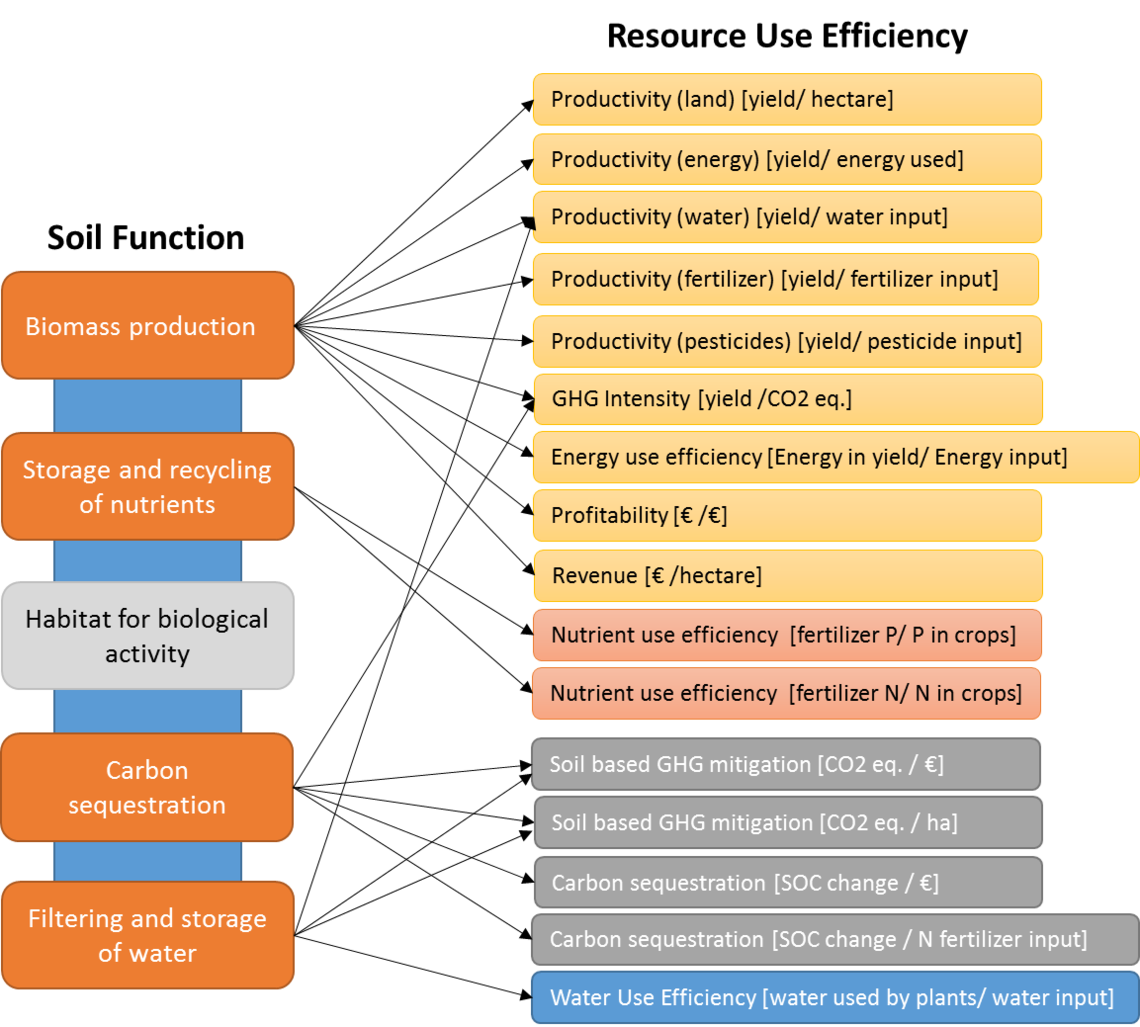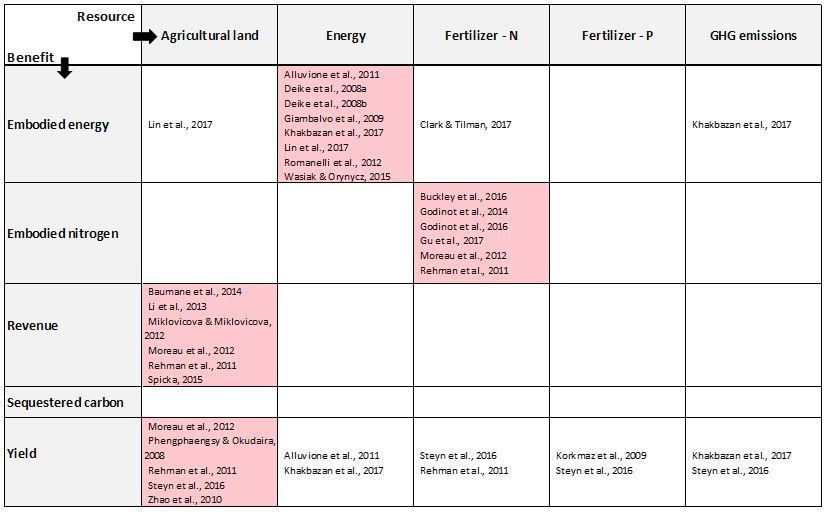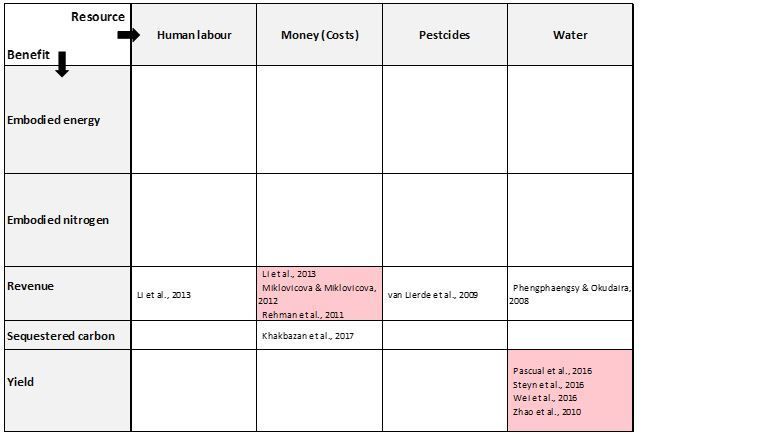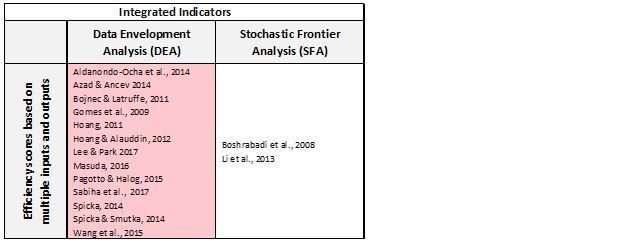Resource Use Efficiencies
In the context of agricultural soil management, we define resource use efficiency as the ratio between benefits generated by agricultural production processes and the amount of stressed resources used. Stressed resources are resources for which competing demands or resource use conflicts exist. This can be due to the fact that a resource is scarce (such as land, water or money) or because its use conflicts with other societal targets (such as pesticide application with biodiversity conservation).
Increasing agricultural resource use efficiency is a target at the global, European and German national policy level. It is central to achieving a highly productive agricultural sector that minimises harmful externalities. Agriculture is characterised by the production of multiple benefits while utilising multiple resources. A comprehensive assessment therefore requires the appraisal of several efficiency indicators.
In the context of soil management we define resource use efficiency as the ratio between benefits generated by agricultural production processes and the amount of resources used. We distinguish between stressed resources for which there is competing demand and abundant resources for which there is no competition. Competition is context-specific and can be due to demand exceeding resource limitations or due to conflicts between resource use and other societal targets (e.g. pesticide application conflicting with biodiversity preservation or emissions of greenhouse gasses conflicting with climate change mitigation). Only the amount of stressed resources is considered in efficiency assessments (di Maio et al., 2017).

As benefit, any quantifiable, positive characteristic of a product can be chosen. This choice exerts a strong influence on calculated efficiencies and often determines efficiency rankings between production alternatives. For example, if weight of harvested biomass is considered, growing strawberries is less efficient than growing ryegrass whereas the situation is reversed if the evaluation is based on gross profits.
As resource, any of the resources used in the production process can be chosen. Here, the system boundaries must be clearly defined because substantial resource consumption can occur in pre- or post-processes related to the process under investigation. For example, if energy efficiency is assessed, it is relevant whether or not energy used in the production of inputs or machinery is considered. Finally, leakage effects, indirect land use changes and especially rebound effects should be accounted for (Lambin & Meyfroidt, 2011).
The following figure illustrates how different categories (impact areas) of soil related resource use efficiency are based on soil functions.


Figure 12: Connection between soil functions and selected resource use efficiency categories relevant for agricultural soil management. Please note that all soil function are connected to and influencing each other.
Figure 12: Connection between soil functions and selected resource use efficiency categories relevant for agricultural soil management. Please note that all soil function are connected to and influencing each other.
Increasing agricultural resource use efficiency is a target at many policy levels.
- Globally, the Sustainable Development Goal (SDG) 12 “sustainable consumption and production” target 12.2 seeks to achieve sustainable management and efficient use of natural resources by 2030 (General Assembly, 2015).
-
At the European level, a 20% reduction of resource inputs within the food chain has been set as a milestone for 2020 (European Commission, 2011). This is to be reached through measures targeting production, distribution and consumption. Increasing efficiency of agricultural production is also a priority within the EU Rural Development Act (European Union, 2013; Spicka, 2015) in which energy efficiency, greenhouse gas emissions per unit produced and water use efficiency are explicitly named.
-
At German national level, the 2014 Policy Strategy on Bioeconomy seeks to improve efficiency of agricultural production by increasing productivity while protecting natural resources and minimising greenhouse gas emissions (BMEL 2014).
Farmers have always sought to optimize their efficiency in the use of limited resources. The most obvious example are efforts to optimize crop yields or revenues per hectare of land. The use of efficiency indicators in this regard is very common. However, increased awareness of the environmental consequences of resource use have extended the list of stressed resources. Today, there is an growing interest to achieve good yields with as little use of pesticides, fertilizer or greenhouse gas emissions as possible. Policy related assessment that do not focus on the individual farm or field but operate at higher spatial scales may also need to consider additional benefits, such as calories produced in a region or energy content of harvest. This results in the need for a whole suit of efficiency indicators.
So far, only few assessments of agricultural resource use efficiency documented in scientific literature explicitly address the role of soils. However, due to the paramount role of soils for crop growth, assessment results often implicitly reflect changes in soil functions. In the context of research to support the transition from a fossil fuel based economy towards a sustainable bioeconomy, it is necessary to determine to what degree agricultural management can increase resource use efficiencies by targeting soil functions and to what degree efficiencies can be increased irrespective of soils.
Resource use efficiency is central to achieving a highly productive agricultural sector while minimising harmful externalities. However, increasing efficiencies may also lead to trade-offs. For example, reducing the amount of labour required to produce a fixed amount of biomass may have negative implications for job provision, nutrient use efficiencies greater than 100% are indicative of nutrient mining by harvest (Scholz & Wellmer, 2015), and maximising the share of biomass harvested relative to net primary production (HANPP) conflicts with biodiversity targets (BIO Intelligence Service, 2012). The potential for such trade-offs should be considered in assessments of resource use efficiency.
The resource use efficiency of agricultural soil management can be assessed by means of efficiency indicators, calculated as the ratio between the amount of benefit generated and the amount of resources used (see Equation 2 above). What type of efficiency indicator is assessed, i.e. the selection of which benefits and which resource use are to be compared, should be based on the intended result of the agricultural management, its main inputs, and the characteristics of management alternatives. More than one efficiency indicator may be required for a comprehensive assessment or to show trade-offs between different types of efficiency.
Temporal scale: Inter-annual yield variability is typical for agriculture. The use of multi-year averages for benefits and resources therefore results in indicators that are more representative of the management systems than single-year variants. Integrating production over several years is also necessary to account for perennial management effects, crop rotations and pre-crops effects (Preissel et al., 2015; Zhang et al., 2017). Where crop rotations of different length are to be compared, normalization can be achieved by dividing total benefits and resource use by the number of years in each rotation (Reckling et al., 2016).
Spatial scale: The spatial scale most suited to the analysis of resource use efficiency depends on the intended users of the assessment results. Farm or field level efficiency is of particular interest to practitioners, especially where they affect economic performance. Typical efficiency indicators at this scale are productivity (Alam et al., 2017; Moreau et al., 2012; Zhang et al., 2016), water use efficiency (WUE) (Pascual et al., 2016; Wei et al., 2016; Zhao et al., 2010), benefit cost ratio (BCR) (Alam et al., 2017; Rehman et al., 2011), nutrient use efficiency (NUE) (nitrogen: Buckley et al., 2016; Gu et al., 2017; phosphorous: Gerber et al., 2014; Zhang et al., 2016) and energy use efficiency (Hill et al., 2006; Arodudu et al., 2017).
Assessments with landscape or global implications are particularly relevant for policy makers. Indicators include greenhouse gas emissions per yield (Khakbazan et al., 2017; Steyn et al., 2016) or GDP contribution per domestic material consumption (European Commission, 2011; European Environment Agency, 2016). Efficiency indicators can also be tailored to assist the assessment of specific research or policy questions. Examples are efficiencies for job provision (jobs generated per hectare of farmland by different biomass usages) (BMEL, 2014) or economic risk efficiency (how does irrigation affect the amount of revenue that can be expected under a defined probability level) (Meyer-Aurich et al., 2016).
Tables 4 and 5 gives an overview about recent studies on resource use efficiency in agricultural and on the efficiency indicators used.
Combining multiple benefits or resources
Agriculture is characterised by the production of multiple benefits such as food, feed, fibre or fuel while using multiple resources like land, water, energy and nutrients. It also generates profits, provides employment and creates habitats for plant and animal species while requiring capital and labour. For a comprehensive efficiency assessment, the appraisal of several benefits and resource uses is therefore essential. For this, assessments can either use multiple efficiency indicators, or apply a single indicator in which multiple benefits or resources are combined.
The most common method to create combined indicators is to express all benefits or resources in monetary terms, based on their explicit or implicit market value. While practical, this approach is often criticised due to the difficulties of reflecting environmental and social consequences in monetary terms, and because values attributed to non-marketed goods vary strongly between assessments (Baveye, 2016).
Alternative methods are often based on benchmarking. For example, Lin & Hülsbergen (2017) determine land use efficiency for a crop rotation by first calculating multiple efficiency indicators for the rotation (such as dry matter per hectare, lipid production per hectare). In a second step, each of these indicators is divided by the respective efficiency of average production in the region. This creates a set of dimensionless values. Finally, the average of these values is calculated and used as the combined indicator. Another benchmarking approach derived from economics is data envelopment analysis (DEA). Linear combinations of all enterprises or processes within in an assessment are used to calculate combinations with the highest (positive) output and smallest use of resources. These combinations constitute the so called efficiency frontier, for which an efficiency of 100% is assumed. Efficiency values of individual enterprises or processes are calculated relative to this frontier. All types of efficiencies can be combined in DEA. For example, Hoang & Alauddin (2010) used data envelopment analysis to create efficiency scores for 30 OECD countries based on agricultural production, costs, use of fertiliser and use of energy. Masuda (2016) calculated eco-efficiency of Japanese wheat production based on global warming potential, aquatic eutrophication potential and yield.
While combined efficiency indicators allow for a quick overview and may facilitate monitoring and communication with stakeholders and policy makers, the selection and weighing of the included efficiency categories and the interpretation of the resulting indicators is challenging. In detailed impact assessment, the use of multiple efficiency indicators may be preferable because they make trade-offs between different efficiency categories directly visible whereas such relationshsips may be obscured in the values of combined indicators.
Please note: Efficiency assessments are well suited to assess performance of agricultural production within a limited number of categories. However, they are unable to provide a holistic view of ecosystem interactions. In this regard, assessment of ecosystem services provides a well suited complementary perspective.
Table 4: Non-integrated indicators for measuring efficiency in agriculture. Overview of studies published between 2008 and 2017 based on Web of Science Core Collection, applying search terms: “efficiency” (title) and “agriculture”, “indicator” (topic). Indicators used in three or more studies are highlighted in red.
Table 4: Non-integrated indicators for measuring efficiency in agriculture. Overview of studies published between 2008 and 2017 based on Web of Science Core Collection, applying search terms: “efficiency” (title) and “agriculture”, “indicator” (topic). Indicators used in three or more studies are highlighted in red.
Table 5: Integrated indicators for measuring efficiency in agriculture. Overview of studies published between 2008 and 2017 based on Web of Science Core Collection, applying search terms: “efficiency” (title) and “agriculture”, “indicator” (topic).
Alam M J, Humphreys E, Sarkar M A R, Sudhir-Yadav (2017) Intensification and diversification increase land and water productivity and profitability of rice-based cropping systems on the High Ganges River Floodplain of Bangladesh. Field Crops Research, 209, 10–26. doi:10.1016/j.fcr.2017.04.008
Aldanondo-Ochoaa A M, Casasnovas-Olivaa V L, Arandia-Miurab A (2014) Environmental efficiency and the impact of regulation in dryland organic vine production. Land Use Policy 36, 275– 284. doi:10.1016/j.landusepol.2013.08.010
Alluvione F, Moretti B, Sacco D, Grignani C (2011) EUE (energy use efficiency) of cropping systems for a sustainable agriculture. Energy, 36, 4468-4481. doi:10.1016/j.energy.2011.03.075
Arodudu O, Helming K, Wiggering H, Voinov A (2017) Integrating agronomic factors into energy efficiency assessment of agro-bioenergy production – A case study of ethanol and biogas production from maize feedstock. Applied Energy, 198,426-439. doi:10.1016/j.apenergy.2017.02.017
Azad A S, Ancev T (2014) Measuring environmental efficiency of agricultural water use: A Luenberger environmental indicator. Journal of Environmental Management, 145, 314-320. doi:10.1016/j.jenvman.2014.05.037
Baumane V, Celms A, Ratkevics A (2014) Assessment for determination possibilities of land use economic efficiency. Engineering for Rural Development, 535-540
Baveye P C, Baveye J, Gowdy J (2016) Soil“ecosystem”services and natural capital: critical appraisal of research on uncertain ground. Frontiers in Environmental Science, 4, article 41. doi:10.3389/fenvs.2016.00041
BIO Intelligence Service - Institute for Social Ecology and Sustainable Europe Research Institute (2012) Assessment of resource efficiency indicators and targets. Final report prepared for the European Commission, DG Environment.
BMEL – German Federal Ministry of Food and Agriculture (2014) Nationale Politikstrategie Bioökonomie - Nachwachsende Ressourcen und biotechnologische Verfahren als Basis für Ernährung, Industrie und Energie. Bundesministerium für Ernährung und Landwirtschaft, Berlin.
Bojnec S, Latruffe L. 2011. Farm size and efficiency during transition: insights from Slovenian farms. Transformations in Business & Economics 10 (3): 104–116.
Boshrabadi H M, Villano R, Fleming E (2008) Technical efficiency and environmental-technological gaps in wheat production in Kerman province of Iran. Agricultural Economics 38, 67–76
Buckley C, Wall D P, Moran B, O’Neill S, Murphy P N C (2016) Farm gate level nitrogen balance and use efficiency changes post implementation of the EU Nitrates Directive. Nutrient Cycling in Agroecosystems, 104, 1–13. doi:10.1007/s10705-015-9753-y
Clark M, Tilman D (2017) Comparative analysis of environmental impacts of agricultural production systems, agricultural input efficiency, and food choice. Environmental Research Letters, 12, 064016. doi:10.1088/1748-9326/aa6cd5
Deike S, Pallutt B, Christen O (2008a) Investigations on the energy efficiency of organic and integrated farming with specific emphasis on pesticide use intensity. European Journal of Agronomy, 28, 461–470. doi:10.1016/j.eja.2007.11.009
Deike S, Pallutt B, Kustermann B, Christen O (2008b) Effects of herbicide application on energy use efficiency and carbon dioxide emissions of cereal cropping systems. Journal of Plant Diseases and Protection, Special Issue 21, 113-119
Di Maio F, Rema PC, Baldé K, Polder M (2017) Measuring resource efficiency and circular economy: A market value approach. Resources, Conservation and Recycling, 122. 163–171. doi:10.1016/j.resconrec.2017.02.009
European Commission (2011) Roadmap to a Resource Efficient Europe. Communication from the Commission. COM/2011/0571 final.
European Environment Agency (2016) Environmental indicator report 2016. In Support to the monitoring of the 7th Environment Action Programme. Publications Office of the European Union, Luxembourg
European Union (2013) Article 5 (5b), Regulation (EU) No 1305/2013 of the European Parliament and of the Council of 17 December 2013 on Support For Rural Development by the European Agricultural Fund for Rural Development (EAFRD) and Repealing Council Regulation (EC) No 1698/2005
General Assembly – United Nations General Assembly. 2015. Transforming our world: the 2030 Agenda for Sustainable Development, A/RES/70/1. Online: https://bit.ly/29kJaEI (accessed 09 August 2019)
Gerber PJ, Uwizeye A, Schulte RPO, de Boer IJM (2014) Nutrient use efficiency: a valuable approach to benchmark the sustainability of nutrient use in global livestock production? Current Opinion in Environmental Sustainability, 9–10, 122–130. doi:10.1016/j.cosust.2014.09.007
Giambalvo D, Alfieri G, Amato G, Frenda A S, Iudicello P, Stringi L (2009) Energy use efficiency of livestock farms in a mountain area of Sicily. Italian Journal of Animal Science, 8 (2), 307-309
Godinot O, Carof M, Vertès F, Leterme P (2014) SyNE: An improved indicator to assess nitrogen efficiency of farming systems. Agricultural Systems, 127, 41–52. doi:10.1016/j.agsy.2014.01.003
Godinot O, Leterme P, Vertès F, Carof M (2016) Indicators to evaluate agricultural nitrogen efficiency of the27 member states of the European Union. Ecological Indicators, 66, 612–622. doi:10.1016/j.ecolind.2016.02.007
Gomes E G, Soares de Mello J C C B, e Souza G S, Angulo Meza L, de Mangabeira J A C (2009) Efficiency and sustainability assessment for a group of farmers in the Brazilian Amazon. Annals of Operations Research, 169, 167-181. doi:10.1007/s10479-008-0390-6
Gu B, Ju X, Chang S X, Ge Y,Chang J (2017) Nitrogen use efficiencies in Chinese agricultural systems and implications for food security and environmental protection. Regional Environmental Change, 17,1217–1227. doi:10.1007/s10113-016-1101-5
Hill J, Nelson E, Tilman D, Polasky S, Tiffany D (2006) Environmental, economic, and energetic costs and benefits of biodiesel and ethanol biofuels. PNAS, 103(30), 1206–11210. doi:10.1073/pnas.0604600103
Hoang VN (2011) Measuring and decomposing changes in agricultural productivity, nitrogen use efficiency and cumulative exergy efficiency: Application to OECD agriculture. Ecological Modelling 222, 164–175. doi:10.1016/j.ecolmodel.2010.09.032
Hoang VN, Alauddin M (2012) Input-Orientated Data Envelopment Analysis Framework for Measuring and Decomposing Economic, Environmental and Ecological Efficiency: An Application to OECD Agriculture. Environmental and Resource Economics, 51, 431–452. doi:10.1007/s10640-011-9506-6
Khakbazan M, Larney F J, Huang J, Mohr R, Pearson D C, Blackshaw R E (2017) Energy Use Efficiency of Conventional versus Conservation Management Practices for Irrigated Potato Production in Southern Alberta. American Journal of Potato Research, 94:105–119. doi:10.1007/s12230-016-9551-3
Korkmaz K, Ibrikci H, Karnez E, Buyuk G, Ryan J, Ulger A C, Oguz H (2009) Phosphorus use efficiency of wheat genotypes grown in calcareous soils. Journal of Plant Nutrition, 32, 2094–2106. doi:10.1080/01904160903308176
Lambin EF, Meyfroidt P (2011) Global land use change, economic globalization, and the looming land scarcity. PNAS, 108 (9), 3465–3472. doi:10.1073/pnas.1100480108
Lee P, Park Y-J (2017) Eco-efficiency evaluation considering environmental stringency. Sustainability, 9, 661. doi:10.3390/su9040661
Li GC, Feng ZC, You LZ ; Fan LX. 2013. Re-examining the inverse relationship between farm size and efficiency. The empirical evidence in China. China Agricultural Economic Review 5 (4): 473–488. DOI:10.1108/CAER-09-2011-0108
Lin HC, Hülsbergen KJ (2017) A new method for analyzing agricultural land-use efficiency, and itsapplication in organic and conventional farming systems in southern Germany. European Journal of Agronomy, 83, 15–27. doi:10.1016/j.eja.2016.11.003
Lin HC, Huber J A, Gerl G, Hülsbergen KJ (2017) Effects of changing farm management and farm structure on energybalance and energy-use efficiency –
A case study of organic and conventional farming systems in southern Germany. European Journal of Agronomy, 82, 242–253. doi:10.1016/j.eja.2016.06.003
Masuda K (2016) Measuring eco-efficiency of wheat production in Japan: a combined application of life cycle assessment and data envelopment analysis. Journal of Cleaner Production, 126, 373-381. doi:10.1016/j.jclepro.2016.03.090
Meyer-Aurich A, Gandorfer M, Trost B, Ellmer F, Baumecker M (2016) Risk efficiency of irrigation to cereals in northeast Germany with respect to nitrogen fertilizer. Agricultural Systems, 149,132–138. doi:10.1016/j.agsy.2016.09.006
Miklovicova J, Miklovicova S (2012) The efficiency matrix as tool for efficiency evaluation of farms in V4 countries. The 6th International Days of Statistics and Economics, Prague, September 13-15, 2012, 794-803
Moreau P, Ruiz L, Mabon F, Raimbault T, Durand P, Delaby L, Devienne S, Vertès F (2012) Reconciling technical, economic and environmental efficiency of farming systems in vulnerable areas. Agriculture, Ecosystems and Environment, 147, 89– 99. doi:10.1016/j.agee.2011.06.005
Pagotto M, Halog A. 2015. Towards a Circular Economy in Australian Agri-food Industry. Journal of Industrial Ecology 20 (5): 1176–1186. DOI:10.1111/jiec.12373
Pascual M, Villar J M, Rufat J. 2016. Water use efficiency in peach trees over a four-years experiment on the effects of irrigation and nitrogen application. Agricultural Water Management 164: 253–266. DOI:10.1016/j.agwat.2015.10.021
Phengphaengsy F, Okudaira H. 2008. Assessment of irrigation efficiencies and water productivity in paddy fields in the lower Mekong River Basin. Paddy and Water Environment 6: 105–114. DOI:10.1007/s10333-008-0108-z
Preissel S, Reckling M, Schläfke N, Zander P. 2015. Magnitude and farm-economic value of grain legume pre-crop benefits in Europe: A review. Field Crops Research 175:, 64–79. DOI:10.1016/j.fcr.2015.01.012
Preissel S, Reckling M, Schläfke N, Zander P (2015) Magnitude and farm-economic value of grain legume pre-crop benefits in Europe: A review. Field Crops Research 175, 64–79. doi:10.1016/j.fcr.2015.01.012
Reckling M, Hecker JM, Bergkvist G, Watson C A, Zander P, Schläfke N, Stoddard F L , Eoryd V, Topp C F E, Maired J, Bachinger J (2016) A cropping system assessment framework—Evaluating effects of introducing legumes into crop rotations. European Journal of Agronomy, 76, 186–197. doi:10.1016/j.eja.2015.11.005
Rehman A, Saleem M F, Safdar M E, Hussain S, Akhtar N (2011) Grain quality, nutrient use efficiency, and bioeconomics of maize under different sowing methods and NPK levels. Chilean Journal of Agricultural Research, 71(4), 586-593
Romanelli T L; de S. Nardi H, Saad F A (2013) Material embodiment and energy flows as efficiency indicators of soybean (glycine max) production in Brazil. Engenharia Agrícola, 32 (2), 261-270. doi:10.1590/S0100-69162012000200006
Sabiha NE, Salim R, Rahman S (2017) Eco-efficiency of high-yielding variety rice cultivation after accounting for on-farm environmental damage as an undesirable output: an empirical analysis from Bangladesh. Australian Journal of Agricultural and Resource Economics, 61, 247–264. doi:10.1111/1467-8489.12197
Scholz R W, Wellmer FW (2015) Losses and use efficiencies along the phosphorus cycle – Part 2: Understanding the concept of efficiency. Resources, Conservation and Recycling, 105, 259–274. doi:10.1016/j.resconrec.2015.10.003
Spicka J. 2014. Production efficiency of mixed farming in the EU regions. In: Masure G. 2014. Economic science for rural development: production and co-operation in agriculture. Economic Science for Rural Development 34: 31–39.
Spicka J 2015. Changes in the energy efficiency of crop production in EU countries. Proceedings of the 7th International Scientific Conference Rural Development 2015, 19.-20. November 2015, Aleksandras Stulginskis University, Lithuania. doi:10.15544/RD.2015.099
Spicka J, Smutka L 2014. The Technical Efficiency of Specialised Milk Farms: A Regional View. The Scientific World Journal, Volume 2014, Article ID 985149, 13 pages. doi:10.1155/2014/985149
Steyn J M, Franke A C, van der Waals J E, Haverkort A J (2016) Resource use efficiencies as indicators of ecological sustainability in potato production: A South African case study. Field Crops Research, 199, 136–149. doi:10.1016/j.fcr.2016.09.020
van Lierde D, Vandenberghe A, Cools A M, de Backer E, Vergucht S (2009) Economic efficiency of the use of plant protection products in Flemish horticulture. Acta Horticulturae, 817, 201-208. doi:10.17660/ActaHortic.2009.817.20
Wang G, Chen J, Wu F, Li Z. 2015. An integrated analysis of agricultural water-use efficiency: A case study in the Heihe River Basin in Northwest China. Physics and Chemistry of the Earth 89–90: 3-9. DOI:10.1016/j.pce.2015.10.009
Wasiak A, Orynycz O. 2014. Formulation of a model for energetic efficiency of agricultural subsystem of biofuel production. In: Kuzle I, Capuder T, Pandzic H. 2014. IEEE International Energy Conference, May 13-16, 2014, Dubrovnik, Croatia, 1271–1275. DOI:10.1109/energycon.2014.6850586
Wei Z, Du T, Zhang J, Xu S, Cambre P J, Davies W J. 2016. Carbon isotope discrimination shows a higher water use efficiency under alternate partial root-zone irrigation of field-grown tomato. Agricultural Water Management 165: 33–43. DOI:10.1016/j.agwat.2015.11.009
Zhang S, Wang L, Mab F, Zhang X, Fu D. 2016. Arbuscular mycorrhiza improved phosphorus efficiency in paddy fields. Ecological Engineering 95: 64–72. DOI:10.1016/j.ecoleng.2016.06.029
Zhang Y, Wang R, Wang S, Wang H, Xu Z, Jia G, Wang X, Li J. 2017. Effects of different sub-soiling frequencies incorporated into no-tillage systems on soil properties and crop yield in dryland wheat-maize rotation. Field Crops Research 209: 151–158. DOI:10.1016/j.fcr.2017.05.002
Zhao L, Wu L, Li Y, Animesh S, Zhu D, Uphoff N. 2010. Comparisons of Yield, Water Use Efficiency, and Soil Microbial Biomass as Affected by the System of Rice Intensification. Communications in Soil Science and Plant Analysis 41: 1–12. DOI:10.1080/00103620903360247




